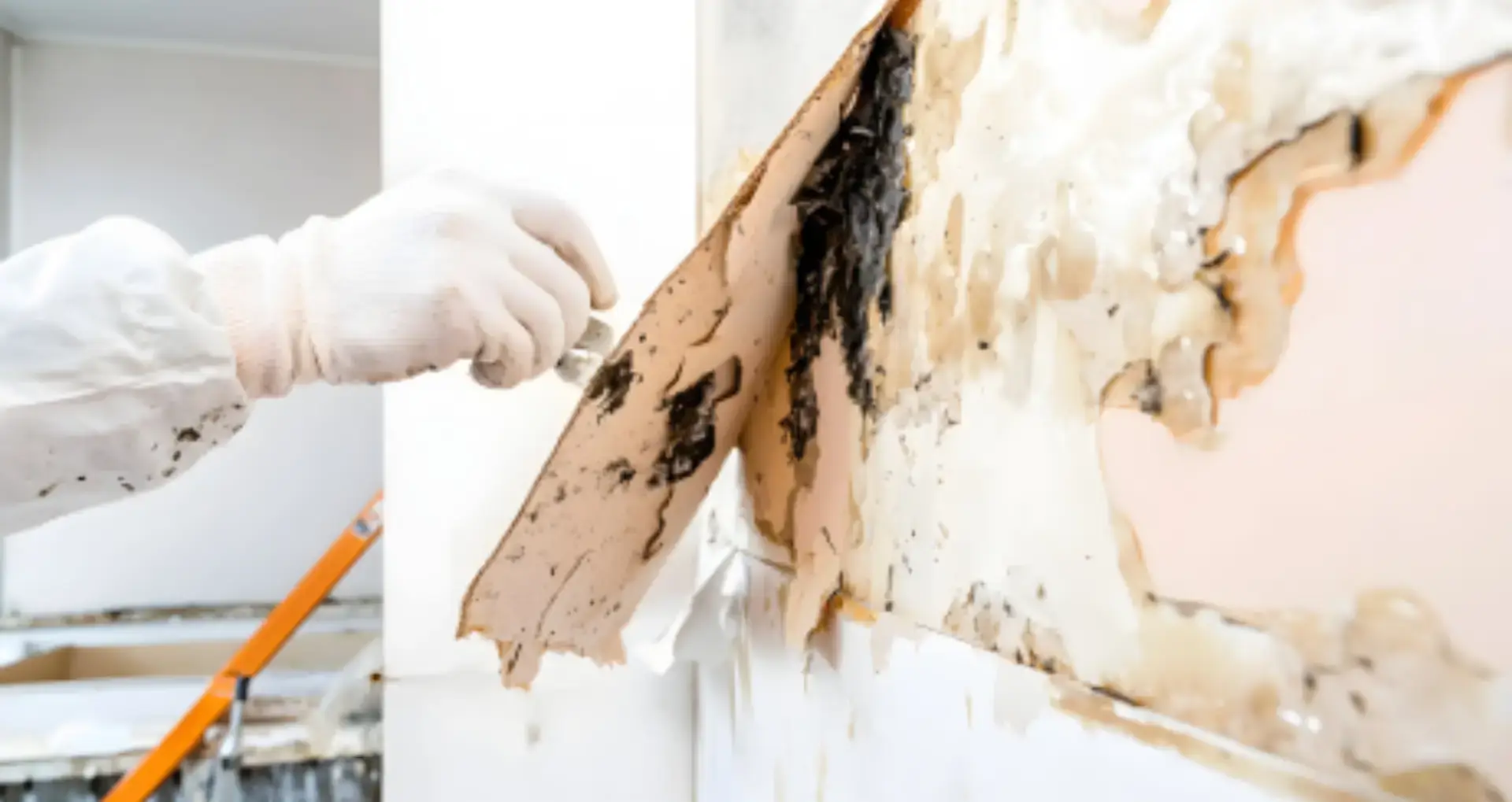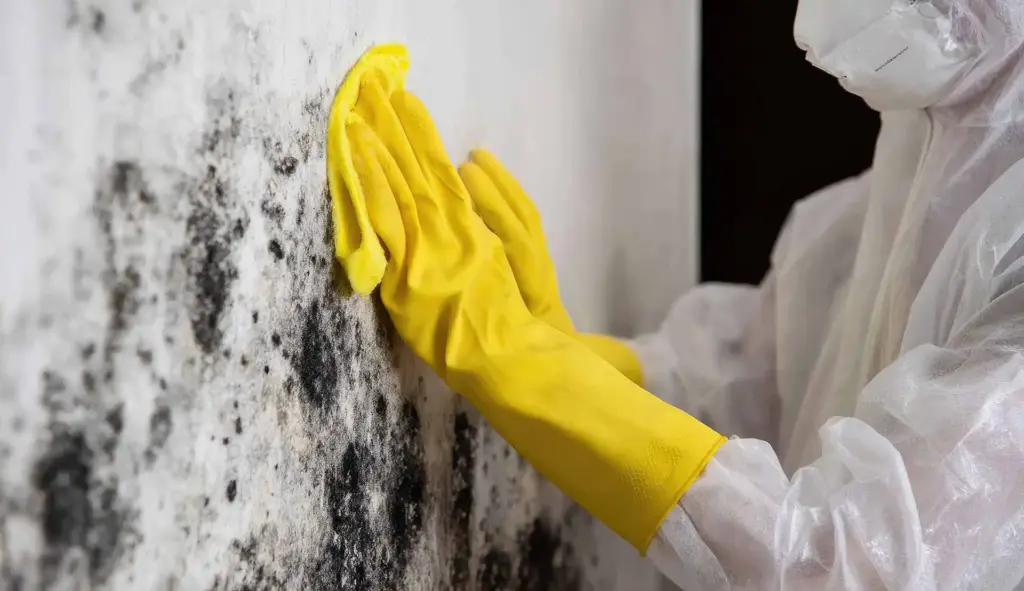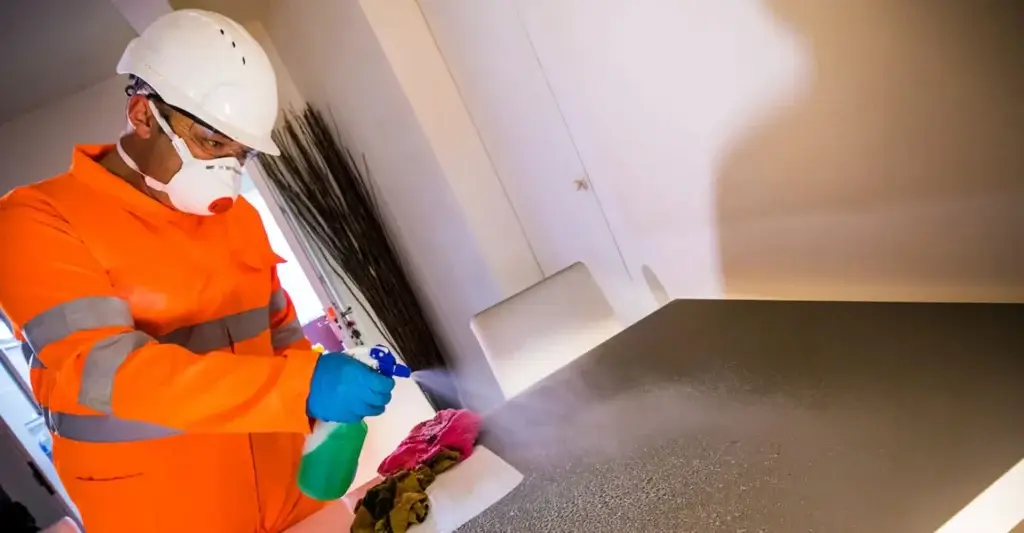Finding mould in your property can be a stressful and frustrating experience. Your first instinct is probably to tackle it yourself, but a quick internet search can lead you down a rabbit hole of misinformation. According to a recent survey, around 1.3 million households in the UK are currently living in damp homes. This is a widespread problem, and getting the facts straight about mould is the first step toward a real solution.
In this guide, we’ll debunk the six most common myths about mould removal. By understanding the truth, you can make the right decision to safely and effectively get rid of mould for good.
Skip to:
6 myths you need to know about mould removal
Myth 1: You can’t see it, so it must be gone.
This is one of the most dangerous misconceptions about mould. The part of the mould you can see is only the surface, it’s like the tip of an iceberg. Mould is a type of fungus that has roots (known as hyphae) that penetrate porous materials like drywall, wood, and grout.
When you simply wipe away the visible surface, you’re leaving the roots to continue growing beneath the surface. This is why mould often comes back in the same spot, seemingly overnight. For true remediation, you need to eliminate the entire spore, including the roots, a job that requires professional equipment and expertise.
Myth 2: Bleach kills mould, so I can do it myself.
This is a very common mistake that can actually make your mould problem worse. While bleach can remove the colour from mould, it doesn’t kill the mould’s roots. It simply sits on the surface, while the water in the bleach penetrates the porous material underneath.
Mould thrives on moisture. So, in effect, you’re not killing the mould, you’re feeding it exactly what it needs to grow and spread. Professional mould remediation specialists use powerful, non-toxic chemicals and techniques designed to eliminate the mould without introducing more moisture.
Myth 3: Only black mould is harmful.
Internet stories about “toxic black mould” have made many people believe that other types of mould are harmless. That is not the case. According to recent research, mould is estimated to be associated with over 5,000 cases of asthma and 8,500 lower respiratory infections in the UK each year.
While some species of mould are more hazardous than others, all mould has the potential to cause health problems, especially for those with allergies, asthma, or a weakened immune system. It’s impossible to know what kind of mould you have just by looking at it. The safest course of action is to treat any mould you find as a potential health risk and have it professionally assessed and remediated as soon as possible.

Myth 4: Mould will return after professional removal.
Mould will only return after a professional service if the underlying cause of the damp isn’t addressed. A professional mould remediation service can remove all visible mould and spores, but if the source of the moisture is still there, the mould will eventually grow back.
A reputable mould specialist will always combine their removal service with a comprehensive plan to identify and fix the source of the damp, whether that’s a leak, poor ventilation, or another issue. This ensures the solution is long-term and effective.
Myth 5: My property needs to be 100% spore-free.
It’s a misconception that a home can be completely free of mould spores. Spores are a natural part of our environment and are always present in the air, indoors and out. You’re breathing in a small number of them right now.
The goal of professional mould removal isn’t to create a completely sterile environment. It’s to bring the level of mould spores back down to a safe, natural level that is no longer a health risk or a threat to your property.
Myth 6: Mould is always caused by a visible leak.
Many homeowners believe that if they can’t see a leak, they don’t have a damp problem. However, mould often flourishes in conditions caused by invisible sources. A recent English Housing Survey found that 9% of private rented homes had a problem with damp, and serious condensation was found to be more prevalent than both rising and penetrating damp. Condensation is one of the most frequent culprits, it’s caused by warm, moist air meeting cold surfaces, and it can silently cause mould growth behind furniture, in wardrobes, or in the corner of rooms. Other hidden sources can include pinhole leaks in pipes within walls or foundations.
Get rid of mould for good
Don’t let mould and damp take over your home and put your health at risk. We don’t just clean the surface, we eliminate the problem for good. Our experts go beyond simple cleaning, using proven drying techniques and specialist mould remediation to tackle the root cause of the damp. This comprehensive approach ensures that the mould won’t return, protecting your family’s health and the long-term value of your home for total peace of mind.
Suspect you have mould? Contact our specialists now for a site survey and expert advice on how to get it resolved quickly. Alternatively, discover more about the service we offer via the link below.
Need to speak to a specialist urgently? Call 01622 926 505
Frequently asked questions about the myths around mould
What are the most common myths about removing mould?
Common myths about mould removal include believing that invisible mould is truly gone, that bleach effectively kills mould, that only black mould is harmful, that professional removal guarantees mould won’t return, that properties can be 100% mould-free, or that mould always indicates a leak.
Does visible mould removal mean it's truly gone?
No, removing only the visible surface mould is often ineffective. Mould is a type of fungi with roots that penetrate surfaces and invisible airborne spores. The entire spore, including its roots, must be completely removed to prevent regrowth.
Can bleach effectively kill and remove mould?
Bleach is not an effective solution for killing mould, especially on porous materials. It typically only removes surface mould, while the water content can penetrate and actually feed the mould’s roots, potentially exacerbating its growth rather than eliminating it.
Is black mould the only harmful type of mould?
No, it’s a myth that only black mould is harmful. While black mould can be dangerous, any type of mould in a property can pose health risks. Professional testing can confirm the specific strain, but safe removal is recommended regardless of colour.
Will mould return after professional remediation, or can a property be 100% mould-free?
While professional remediation significantly reduces mould spores, mould can return if the underlying cause (like excess moisture, warmth, or darkness) is not addressed. Additionally, properties cannot be 100% mould-free, as mould spores naturally occur in the air; the key is preventing them from growing on moist surfaces.
Does mould growth always mean there's a leak or standing water?
No, mould growth does not always indicate a leak or standing water. While these are common causes, other sources of excess moisture like condensation and general dampness can also lead to significant mould growth. Identifying the exact source of moisture often requires professional help.
Why is professional mould removal recommended over DIY methods?
Professional mould removal is recommended because experts can accurately identify the root cause of the mould, safely and effectively remove all traces of mould (including invisible roots and airborne spores using specialised equipment), and sanitise the property, thereby preventing recurrence and protecting health.

Chris Hedges - Head of Marketing
With over 25 years' experience, Chris is adept at defining and driving strategy, while also enjoying hands-on operational delivery. He believes in an equal blend of creativity and analytical scrutiny, always finding inventive ways to achieve objectives, underpinned by evidence. Chris’s philosophies are simple: don't overcomplicate, always prioritise customer experience, and bend the rules just enough to cut through the noise and drive momentum and growth.





















